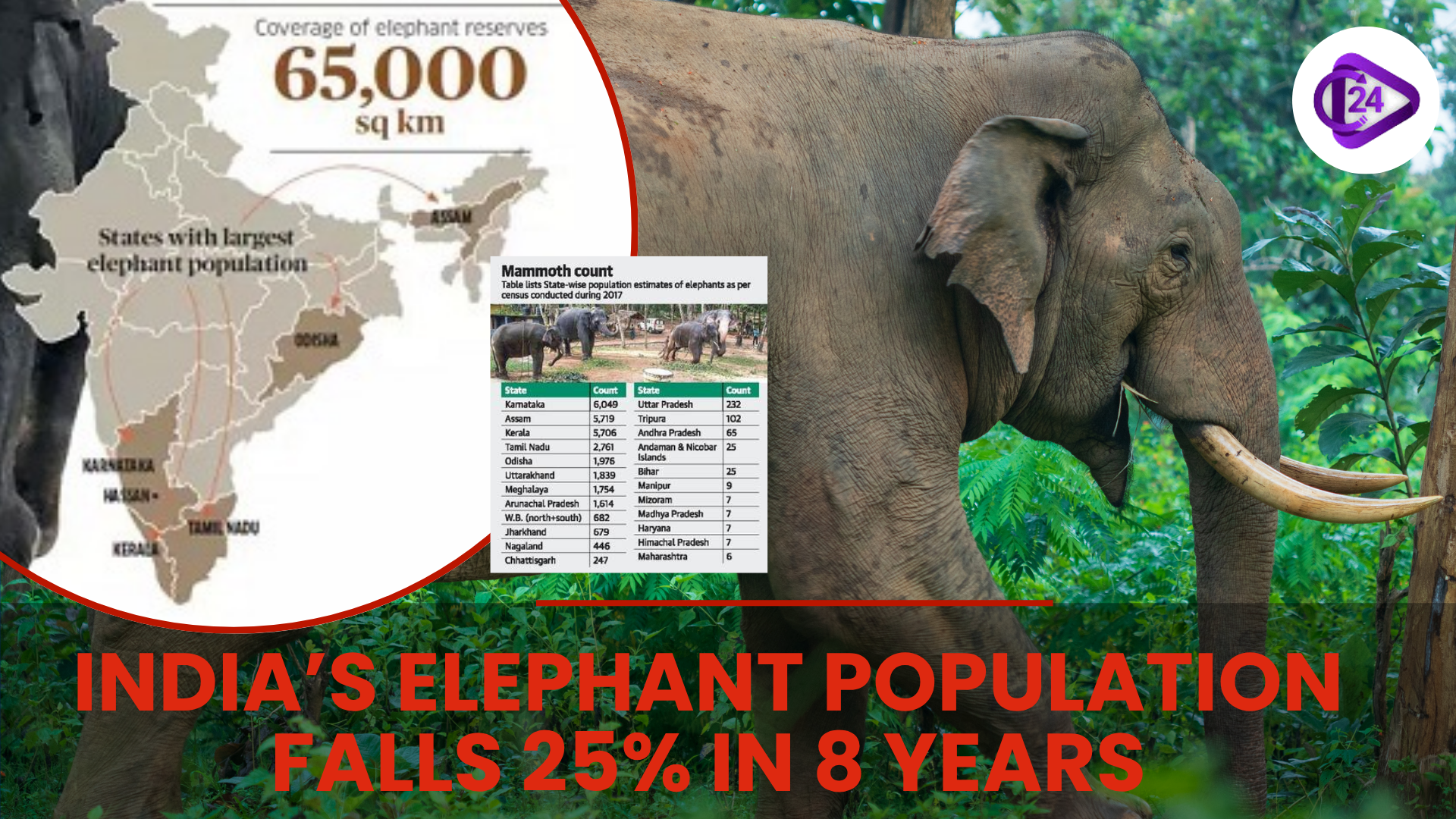
More than 70% of the wild tigers in the world live in India and it is important that the population of tigers be monitored as a form of conservation of biodiversity there. Tiger density, or the number of tigers per 100 sq. km is a very important indicator of the health of an ecosystem, and of conservation success. Recent figures indicate that the Kaziranga Tiger Reserve in Assam is classified as the third place in India with tiger density.
Highlights of recent study
-
Location: Assam; spans 1,307.49 sq. km
-
Tiger Population (2024): 148 individuals
-
Tiger Density: 18.65 tigers per 100 sq. km
-
Rank: 3rd in India, after:
-
Bandipur Tiger Reserve (Karnataka): 19.83/100 sq. km
-
Corbett Tiger Reserve (Uttarakhand): 19.56/100 sq. km
-
Division-Wise Tiger Count in Kaziranga Landscape (2024)
|
Division |
No. of Tigers (2024) |
No. of Tigers (2022) |
|
Eastern Assam Wildlife Division |
115 |
104 |
|
Biswanath Wildlife Division |
27 |
- (first survey) |
|
Nagaon Wildlife Division |
6 |
Not specified |
The total of 148 tigers in the Kaziranga landscape indicates both stable numbers and effective conservation.
Methodology Used
-
The time range of the survey: December 2023 April 2024
-
Technique: Camera trapping via the Spatially Explicit Capture Recapture (SECR) technique
-
Guidelines Adhered To: National Tiger Conservation Authority (NTCA) and Wildlife Institute of India (WII) guidelines
Conservation Significance
-
The density rate is high on Kaziranga which is a good ecological sign- indicating prey base, its safe habitat and high efforts to curb poaching.
-
It implements the comprehensive approach of tiger conservation in Assam that aims at restoring the habitat and coordination across the divisions.
-
The inclusion of the Biswanath Division for the first time indicates the possibility of expanding the range and the potential of landscape level conservation of tigers.
Broader Implications
-
Replicable Model: The model of Kaziranga has replicable strategies to other reserves.
-
Biodiversity Corridors: Increase in the distribution of tigers in the divisions will need ecological corridors and human-wildlife conflict reduction.
-
Tourism & Livelihoods: Presence of high density of tigers may be used to enhance eco-tourism which will contribute to household income of the locals.
About Tiger Reserve
About tiger
-
Tiger ( Panthera tigris ) is an apex predator and keystone species, i.e. it is one of the most important species in the preservation of the ecological balance.
-
The tiger is a national animal of India, which was recognised in 1973, and it represents the nation which is devoted to the conservation of bio-diversity.
Significance of Tiger Conservation
-
Ecological Role: Tigers are at the apex of the food chain hence, control the populations of prey and maintain the ecosystem of forests.
-
Umbrella Species: The conservation of tigers means the preservation of biological diversity since its habitat is in the range of different plants and animals.
-
Cultural and Ecotourism Value: The tigers have rich cultural value that was incorporated in Indian mythology and enhances ecotourism that gives local communities chances to make a living.
Rank and Allocation
-
It has an IUCN status of Endangered.
-
Listed in the first schedule of the Wildlife (Protection) Act, 1972.
-
According to the All India Tiger Estimation 2018, there are 2,967 tigers in the country which constitutes close to 75 per cent of all wild tigers in the world.
-
At present there are 57 notified Tiger Reserves in 18 states.
Institutional and Legal structure
-
Project Tiger (1973)
-
It began last year with 9 reserves, and has grown to 57.
-
Core- buffer approach to habitat conservation.
-
The Ministry of Environment, Forest and Climate Change (MoEFCC), has been sponsoring this Centrally Sponsored scheme.
-
-
National Tiger Conservation Authority (NTCA)
-
Since 2005 after the recommendations of the Tiger Task Force.
-
Wildlife (Protection) Act, 1972 (amended in 2006) Statutory body.
-
Oversees carrying out Project Tiger and adherence to norms of conservation.
-
-
Wildlife Institute of India (WII)
-
It is a training and research center on wildlife conservation based in Dehradun.
-
It is central to tiger census and technical evaluation.
-
The Approaches of Monitoring and Prevention
-
M-STrIPES: Anti-poaching and ecological monitoring mobile application.
-
Camera Trapping and DNA Fingerprinting: Ways to do correct population estimation accurately.
-
LIDAR Technology: This will be to control habitat areas and areas where there are conflicts between humans and animals.
International and Binary Cooperation
-
Global Tiger Forum (GTF): A feature unique to all other entities concerned with tiger conservation is that Global Tiger Forum is an inter-governmental organization located in New Delhi.
-
Tx2 Goal: Green promises to make two times the number of tigers by the year 2022 (base year: 2006). The only country that can fulfill this target is India.
-
Global Tiger Initiative (GTI): Interprogram alliance that emerged in 2008 with the efforts of the World Bank to facilitate the coordination of the tiger conservation initiatives across countries.
-
Bilateral Agreements: The cross border conservation bamboo zones through countries such as Nepal, Bangladesh, Bhutan, China and Russia.
Challenges
-
Fragmentation and disruption of the habitat and corridors.
-
Poaching and illegal wildlife trade.
-
The conflict situation between people and tigers in marginal regions.
-
Tiger habitat stress because of climate change (e.g. Sunderbans).
Way Forward
-
Empower eco-sensitive areas, as well as wildlife corridors.
-
Relocation with compensation which would be community based conservation.
-
Landscape level cross-border conservation.
-
An environmentally friendly tourism policy in order to prevent habitat deterioration
Conclusion
The fact that Kaziranga has registered the highest third density of tigers is testament to the fact that India leads in the area of conservation as evidenced in the project tiger framework. The health of these efforts to maintain this success will lie in continued actions to support scientific monitoring, landscape level planning and community involvement. The case example of Assam demonstrates how the national biodiversity goals can be smoothly supplemented with nation level efforts and be of use to the Global Tiger Recovery Programme (GTRP).



 World Soil Day 2025: Celebrating “Healthy Soils for Healthy Cities”
World Soil Day 2025: Celebrating “Healthy Soils for Healthy Cities” New Seismic Zonation Map of India
New Seismic Zonation Map of India Cyclone Fina Hits Northern Australia With Destructive Force
Cyclone Fina Hits Northern Australia With Destructive Force Tiger Returns to Gujarat After 32 Years | Historic Wildlife Comeback 2025
Tiger Returns to Gujarat After 32 Years | Historic Wildlife Comeback 2025 Namdapha Butterfly Festival Showcases the Wild Heart of Arunachal Pradesh
Namdapha Butterfly Festival Showcases the Wild Heart of Arunachal Pradesh Gogabeel Lake Achieves Ramsar Status for Biodiversity and Conservation
Gogabeel Lake Achieves Ramsar Status for Biodiversity and Conservation Cyclone Montha Makes Landfall Near Kakinada, Bringing Destruction to Andhra and Odisha
Cyclone Montha Makes Landfall Near Kakinada, Bringing Destruction to Andhra and Odisha India Conducts First-Ever DNA-Based Elephant Census, Reveals Population Decline by 25%
India Conducts First-Ever DNA-Based Elephant Census, Reveals Population Decline by 25% Maharashtra Gets India’s First Cooperative CBG Plant | 12 Tonnes Biogas Daily Production
Maharashtra Gets India’s First Cooperative CBG Plant | 12 Tonnes Biogas Daily Production Pulicat Fishermen Demand Long-Term Solution as Silt Threatens Lake and Livelihoods
Pulicat Fishermen Demand Long-Term Solution as Silt Threatens Lake and Livelihoods






